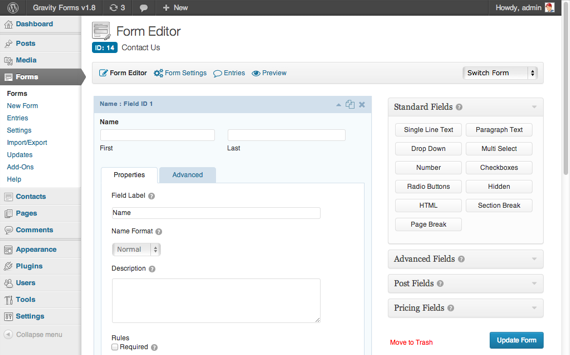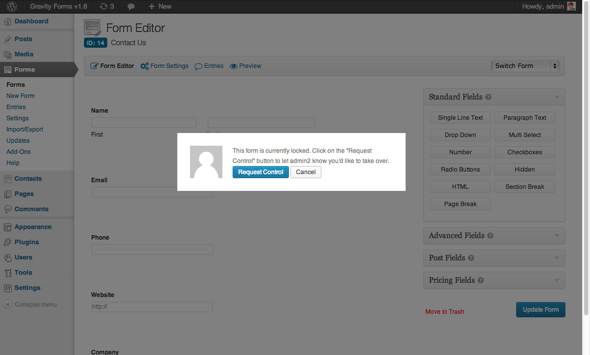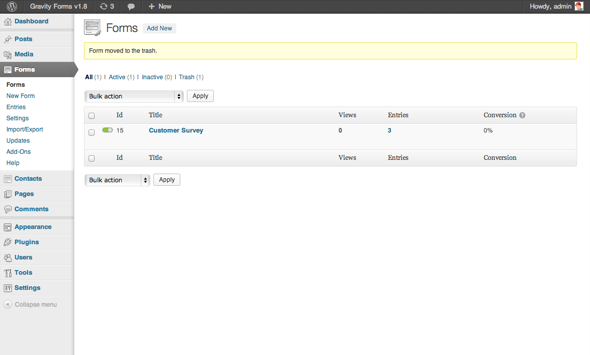Gravity Forms v1.8 Beta 1 Released
We are extremely pleased to announce the availability of Gravity Forms v1.8 Beta 1. This release introduces a major new enhancements such as drag-n-drop Multi-File Uploads.
You will also notice UI refinements, WordPress heartbeat integration, form trash, and other enhancements.
This release will really be a treat for developers as it introduces the latest version of our Add-On Framework for developing Gravity Forms Add-Ons as well as the introduction of a complete API that allows developers to interact with a specific Gravity Forms install to add, update, delete and return Gravity Forms data. And yes, there is already developer documentation available for both!
Like Gravity Forms v1.7, we have refined and enhanced a lot of the core code within Gravity Forms in order to set things up for some very big things going forward. We’ll be introducing very exciting new features, enhancements, Add-Ons and let’s just say some products that are even bigger than Add-Ons but all tie into Gravity Forms. It’s exciting times here at Rocketgenius and for Gravity Forms users! We’ve only just begun.
We will be releasing v1.8 via automatic upgrade once it has undergone beta testing to our satisfaction. Own Gravity Forms and want to take it for a spin and help us test out the new features? Grab a copy on the downloads page!
Please report any bugs or issues you may encounter to our support team and make it clear it is in reference to the Gravity Forms v1.8 Beta 1 release when doing so.
Please Note: This is a beta release and as such you should use at your own risk. We are still actively working on UI enhancements and refinements for the final public release. Gravity Forms 1.8 requires WordPress 3.7+.
Documentation for the features and functionality in Gravity Forms v1.8 is still in progress. The Gravity Forms documentation as a whole is being completely overhauled and will launch with the final release of Gravity Forms v1.8. Please be patient as we completely overhaul our documentation from the ground up. However, documentation does exist for the new Add-On Framework as well as the new API.
Here is a rundown of what you’ll find in Gravity Forms v1.8…
UI Refinements

We have made the decision to standardize the iconography used within Gravity Forms and all of our Add-Ons to utilize web fonts.
With Gravity Forms v1.8 we have begun this transition. You’ll notice that some of the icons are extremely similar to the previous icons, others may be a little different. We will continue to refine the UI in subsequent beta releases.
We also have additional changes that we will roll out once WordPress v3.8 is released publicly and incorporates planned WordPress admin UI enhancements being introduced at that time.
Multi-File Upload

Finally, multi-file upload functionality has come to Gravity Forms!
But you didn’t think we’d stop there did you? We have incorporated the same file upload functionality that WordPress utilizes. You can allow users to drag-n-drop files directly on to the field in order to upload them.
Along with being able to upload multiple files, you can set limits such as: how many files can be uploaded as well as set a file upload limit on individual files.
WordPress Heartbeat Integration

WordPress v3.6 introduced the Heartbeat API. This allows WordPress to know when multiple users are viewing or editing the same thing. It is used to prevent multiple people from trying to make changes to the same thing at the same time. We have hooked into this API and brought this functionality to Gravity Forms.
Gravity Forms will now utilize the Heartbeat API to prevent multiple users from editing: Forms, Entries, Form Settings or Gravity Forms Settings. Entries can still be viewed even if someone is editing it; however, it will let you know on the Entry Detail page that a user is editing the entry. Only the Entry Editor will not be enabled if someone else is editing the entry.
One slide difference we’ve made compared to WordPress is that in order to take control of editing a form, entry or settings, you must request control from the user who is already editing it. They can then approve or deny the transfer of control to you. This is very important because once control is passed, any unsaved changes will not be saved.
Form Trash

Entries have trash to prevent you from accidentally deleting entries, so why not Forms? Now they do!
Forms now incorporate Trash functionality so that the first step to deleting a form is to send it to Trash. It can then be restored or deleted permanently.
When a Form has been added to the Trash it will no longer appear as an available Form on the site, in form selections, etc. and it’s entries will be hidden until it is either restored or deleted permanently.
Other Enhancements
- Enhanced Entry Search
- You can now search entries for the value of specific fields as well as use operators such as “is”, “is not”, “contains”, etc. The operators available will depend on the field type selected.
- Enhanced Entry Export
- The Entry Export now allows you to apply Conditional Logic so that only the entries that meet certain criteria will be exported.
- Page Confirmation Query String
- When opting to redirect to a WordPress Page for the Confirmation you can now pass custom query string parameters as you can with the Redirect Confirmation.
- Notification Enhancements
- Notifications can now be set as active/inactive as well as duplicated.
- Confirmation Enhancements
- Confirmations can now be set as active/inactive as well as duplicated.
- Port Category Field Hierarchy
- The Post Category Field when configured to only show selected categories will now maintain the category hierarchy automatically.
- Form Scheduling
- Form Scheduling now allows you to display a custom message when the form cannot be displayed because the Start Date has not yet begun.
- Form Sorting
- The Form List page that lists all of your Forms now supports sorting on the columns so you can sort by id, name, etc.
- WordPress Multi-Site
- Gravity Forms now supports being installed within the MU-PLUGINS folder on WordPress Multi-Site installations.
Add-On Framework
The Add-On Framework provides basic functionality for developers when creating new add-ons for Gravity Forms. Here is some of the things it can do for Add-On developers:
- Initialization
- Enforcing Gravity Forms minimum version requirement
- Creating settings pages (both add-on and form settings)
- Creating form feeds
- Creating results pages for Add-Ons that display results like Surveys, etc.
- And much more…
Find out more about the Gravity Forms Add-On Framework and view it’s documentation to find out more!
API
The Gravity Forms API provides developers with a future-proof way to access some of the common core functionality in Gravity Forms. There are two ways to leverage the API: API Functions in the GFAPI class or Via HTTP using the Web API. The API can be used to add, update, delete and return Gravity Forms data such as forms and entries.
As with the Add-On Framework, you can find out more about the brand new Gravity Forms API and view it’s documentation to find out more!
These are the major features and enhancements made in this release. There are other enhancements, new hooks etc. but they are simply too numerous to cover in this post. For a complete rundown of all of the updates, enhancements, bug fixes, etc. you can check out the complete changelog file within the beta release zip file. Enjoy!
